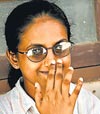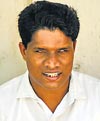
Feeling on top of the worldThey couldn’t see but they climbed Sri Pada They felt the chill of the mountain breeze and the warmth of the rising sun. They heard the sounds of the approaching dawn – birdsong and the stirring of life. But, they could not see the colours of the sunrise or the beauty of the surrounding landscape – except in their imagination. This did nothing to detract from the experience of the 35 visually handicapped young people who undertook the journey up Sri Lanka’s sacred mountain, Sri Pada, or Adam’s Peak in February this year. Assisted by those who were partially blind as well as those who could see, they trekked up the mount, to fulfil – as others do – a spiritual goal. “This is the first time in Sri Lanka that such an expedition has been organised on a mass scale,” says S.L. Hettiarachchi, Executive Director of the Sri Lanka Council for the Blind, which organised the expedition as part of their psychosocial development programme. “It’s all about social inclusion – the blind should not be deprived of enriching life experiences that others enjoy.”
As they left Colombo on the morning of February 24, a Saturday, all the pilgrims wore yellow wristbands with the slogan, “Make Sri Lanka Disabled Friendly”, donated by the ‘Enable the Disabled’ national programme. The guides were briefly trained on the needs of the blind and how to assist them on the journey. Reaching Hatton at 11 p.m., they stopped for a change of clothes and some coffee. Then, the group of 62, including the guides, began their ascent at 2 a.m. from the side of the mountain that pilgrims usually descend from, since it would be less crowded at that time. Working as a team, they helped each other progress up the steep and rocky path. Those who could see would constantly describe the surroundings to their blind companions. “A sound, a word, was enough to create a picture in our minds,” says J.K Stella Mary, a young graduate teacher who has been blind from the age of four. “What others experienced through sight, we discovered in a bodily sense.”
The gradual change in the weather as they reached a higher altitude, the gentle gurgle and the very scent of water as they neared the Seetha Gangula stream and the searing heat of the afternoon sun as they descended were among the sensations they will remember. However, they did have many obstacles to face, not least the attitude of other pilgrims who felt the team with the yellow bands was a hindrance to their own quick descent. “We heard many negative remarks,” says 27-year-old Sanjeewa Karunaratna, a sports instructor. “Many questioned what blind people like us could achieve by this pilgrimage.” On the other hand, he says, there were also many who paused to help them or encourage them. Combined with fatigue and the sheer difficulties of finding their way uphill, particularly the steep Mahagiridamba precipice – the last leg of the journey – there were many discouraging moments, he says. However, finally reaching their destination that morning, and being able to participate in the religious ceremonies at the Siripa Maluwa, or the place of worship that covers the sacred footprint, made it all worthwhile. “It’s not just about religious rituals,” says Stella, “We were able to experience a unique Sri Lankan pilgrimage despite being blind.” Rested and rewarded, the triumphant team was now prepared to face the descent. Still, there were unexpected setbacks, with 20-year-old Harshi Mendis, the youngest member of the team, stumbling and twisting her ankle. “I almost gave up, I didn’t think I could make it,” she remembers. Supported by two of the guides and encouraged by the whole team, she limped her way to the foot of the mountain. Finally, at 5 p.m., they reached Nallathaniya at the foot of the mountain. “Many people helped us to achieve this,” says Mr. Hettiarachchi. The transport was entirely funded by FIDSRO, an NGO in Kandy, and they were also assisted by the National Youth Award Authority, headed by Chairman Saman Amarasinghe, who provided caps, haversacks and water bottles. All the meals were provided by donors. It was a joyous group that returned to Colombo at 1.30 a.m. the next day, where Mr. Hettiarachchi who had been keeping vigil at the Council premises since seeing them off, welcomed them. “It was a wonderful feeling,” says Sanjeewa, “We had just one goal – that each of us would be able to perform the pilgrimage and return safe – and thanks to our determination and will-power, as well as the cooperation of the team, we did.” |
|| Front
Page | News | Editorial | Columns | Sports | Plus | Financial
Times | International | Mirror | TV
Times | Funday
Times || |
| |
Copyright
2007 Wijeya
Newspapers Ltd.Colombo. Sri Lanka. |

